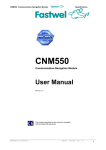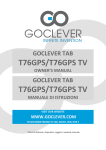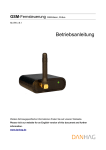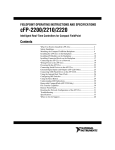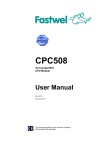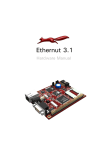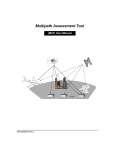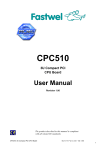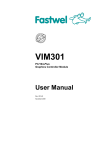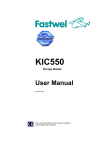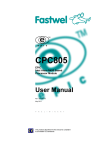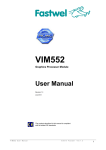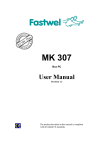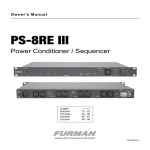Download CNM350 User Manual
Transcript
CNM350 The communication-navigation module User Manual Rev. 001 E December 2012 The product described in this manual is compliant with all related CE standards. Product Title: Document name: Manual version: Ref. docs: CNM350 CNM350 User Manual 001 E ИМЕС.468157.001РЭ_CNM350_v1.7.doc Copyright © 2012 Fastwel Co. Ltd. All rights reserved. Revision Record Rev. Index Brief Description Product Index Date 001 Initial version CNM350 December 2012 Contact Information Fastwel Co. Ltd Fastwel Corporation US Address: 108 Profsoyuznaya st., Moscow 117437, Russian Federation 55 Washington Street, Suite 310 Brooklyn, New York 11201 USA Tel.: +7 (495) 232-1681 +1 (718) 554-3686 Fax: +7 (495) 232-1654 +1 (718) 797-0600 Toll free: Technical support E-mail: [email protected] Web: http://www.fastwel.com/ +1 (877) 787-8443 (1-877-RURUGGED) 1.347.585.4505 CNM350 Table of Contents Table of Contents..................................................................................................................................................... 2 List of Tables............................................................................................................................................................ 3 List of Figures .......................................................................................................................................................... 3 Notation Conventions............................................................................................................................................... 4 General Safety Precautions ..................................................................................................................................... 5 Unpacking, Inspection and Handling........................................................................................................................ 6 Three Year Warranty ............................................................................................................................................... 7 1 Introduction............................................................................................................................................ 8 1.1 1.2 1.3 1.4 1.5 2 Arrangement and operation of the Module....................................................................................... 12 2.1 2.2 2.3 2.4 3 Marking of the Module ................................................................................................................................ 17 Marking of consumer packaging ................................................................................................................. 17 Package...................................................................................................................................................... 17 Preparation of the Module for operation........................................................................................... 18 4.1 4.2 4.3 4.4 4.5 4.6 5 Appearance and location of components.................................................................................................... 12 Structure and interaction of nodes .............................................................................................................. 12 Installation of jumpers and external plugs................................................................................................... 14 Connection of external aerials .................................................................................................................... 16 Markin and Package ........................................................................................................................... 17 3.1 3.2 3.3 4 Designation of the Module ............................................................................................................................ 8 Technical characteristics of the Module........................................................................................................ 8 1.2.1 Interface РС/104+........................................................................................................................ 8 1.2.2 GSM-modem (in CNM350-01 and CNM350-02 variants) ............................................................ 8 1.2.3 GPS/GLONASS-receiver (in CNM350-01 and CNM350-03 variants).......................................... 9 1.2.4 Control and indication bodies....................................................................................................... 9 1.2.5 Power supply ............................................................................................................................... 9 1.2.6 Resistance to climatic influences ............................................................................................... 10 1.2.7 Resistance to mechanical stress ............................................................................................... 10 1.2.8 Overall dimensions .................................................................................................................... 10 1.2.9 Weight of the Module ................................................................................................................. 10 1.2.10 MTBF ......................................................................................................................................... 10 Variants of the Module arrangement........................................................................................................... 10 Set of delivery ............................................................................................................................................. 11 Service software and documentation.......................................................................................................... 11 Information about types of dangerous influences ....................................................................................... 18 General requirements ................................................................................................................................. 18 Electrostatic safety requirements................................................................................................................ 18 Overvoltage protection requirements.......................................................................................................... 19 Unpacking and external examination.......................................................................................................... 19 Installation of the Module............................................................................................................................ 19 Operation of the Module ..................................................................................................................... 21 5.1 5.2 5.3 5.4 General instructions.................................................................................................................................... 21 Installation of program drivers of COM-ports .............................................................................................. 21 Operation with GSM-modem (CNM350-01 and CNM350-02) .................................................................... 21 Operation with GPS/GLONASS-receiver (CNM350-01 and CNM350-03) .................................................. 23 6 Maintenance......................................................................................................................................... 24 7 Useful Abbreviations, Acronyms and Short-cuts.............................................................................. 25 CNM350 User Manual 2 ©2012 Fastwel Ver.001 E CNM350 List of Tables Table 2-1: Table 2-2: Table 2-3: Table 2-4: Table 2-5: Table 2-6: Designation of COM-ports PCI-UART ............................................................................................. 13 Designation of GPIO-ports PCI-UART ............................................................................................ 14 Designation of GSM-modem condition light-emitting diode ............................................................. 14 Designation of the Module jumpers ................................................................................................. 15 Designation of DIP-switch SA1........................................................................................................ 15 Designation of XP3 (Audio) plug contacts ....................................................................................... 15 List of Figures Figure 2-1: Figure 2-2: Appearance and location of components of the Module..................................................................... 12 Structure of the Module .................................................................................................................... 13 All information in this document is provided for reference only, with no warranty of its suitability for any specific purpose. This information has been thoroughly checked and is believed to be entirely reliable and consistent with the product that it describes. However, Fastwel accepts no responsibility for inaccuracies, omissions or their consequences, as well as liability arising from the use or application of any product or example described in this document. Fastwel Co. Ltd. reserves the right to change, modify, and improve this document or the products described in it, at Fastwel's discretion without further notice. Software described in this document is provided on an “as is” basis without warranty. Fastwel assumes no liability for consequential or incidental damages originated by the use of this software. This document contains information, which is property of Fastwel Co. Ltd. It is not allowed to reproduce it or transmit by any means, to translate the document or to convert it to any electronic form in full or in parts without antecedent written approval of Fastwel Co. Ltd. or one of its officially authorized agents. Fastwel and Fastwel logo are trademarks owned by Fastwel Co. Ltd., Moscow, Russian Federation. Ethernet is a registered trademark of Xerox Corporation. IEEE is a registered trademark of the Institute of Electrical and Electronics Engineers Inc. Intel is a trademark of Intel Corporation. Pentium M and Celeron M are trademarks of Intel Corporation. Microsoft is a trademark of the Microsoft corporation. In addition, this document may include names, company logos and trademarks, which are registered trademarks and, therefore, are property of their respective owners. Fastwel welcomes suggestions, remarks and proposals regarding the form and the content of this Manual. CNM350 User Manual 3 ©2012 Fastwel Ver.001 E CNM350 Notation Conventions Warning, ESD Sensitive Device! This symbol draws your attention to the information related to electro static sensitivity of your product and its components. To keep product safety and operability it is necessary to handle it with care and follow the ESD safety directions. Caution: Electric Shock! This symbol warns about danger of electrical shock (> 60 V) when touching products or parts of them. Failure to observe the indicated precautions and directions may expose your life to danger and may lead to damage to your product. Warning! Information marked by this symbol is essential for human and equipment safety. Read this information attentively, be watchful. Note... This symbol and title marks important information to be read attentively for your own benefit. CNM350 User Manual 4 ©2012 Fastwel Ver.001 E CNM350 General Safety Precautions This product was developed for fault-free operation. Its design provides conformance to all related safety requirements. However, the life of this product can be seriously shortened by improper handling and incorrect operation. That is why it is necessary to follow general safety and operational instructions below. Warning! All operations on this device must be carried out by sufficiently skilled personnel only. Warning! Please, keep in mind that any physical damage to this product is not covered under warranty. Also, be careful not to drop the product. Note: This product is guaranteed to operate within the published temperature ranges and relevant conditions. However, prolonged operation near the maximum temperature is not recommended by Fastwel or by electronic chip manufacturers due to thermal stress related failure mechanisms. These mechanisms are common to all silicon devices, they can reduce the MTBF of the product by increasing the failure probability. Prolonged operation at the lower limits of the temperature ranges has no limitations. Caution, Electric Shock! Before installing this product into a system and before installing other devices on it, always ensure that your mains power is switched off. Always disconnect external power supply cables during all handling and maintenance operations with this module to avoid serious danger of electrical shock. CNM350 User Manual 5 ©2012 Fastwel Ver.001 E CNM350 Unpacking, Inspection and Handling Please read the manual carefully before unpacking the module or mounting the device into your system. Keep in mind the following: ESD Sensitive Device! Electronic modules and their components are sensitive to static electricity. Even a non-perceptible by human being static discharge can be sufficient to destroy or degrade a component's operation! Therefore, all handling operations and inspections of this product must be performed with due care, in order to keep product integrity and operability: Preferably, unpack or pack this product only at EOS/ESD safe workplaces. Otherwise, it is important to be electrically discharged before touching the product. This can be done by touching a metal part of your system case with your hand or tool. It is particularly important to observe anti-static precautions when setting jumpers or replacing components. If the product contains batteries for RTC or memory back-up, ensure that the module is not placed on conductive surfaces, including anti-static mats or sponges. This can cause shortcircuit and result in damage to the battery and other components. Store this product in its protective packaging while it is not used for operational purposes. Unpacking The product is carefully packed in an antistatic bag and in a carton box to protect it against possible damage and harmful influence during shipping. Unpack the product indoors only at a temperature not less than +15°C and relative humidity not more than 70%. Please note, that if the product was exposed to the temperatures below 0°С for a long time, it is necessary to keep it at normal conditions for at least 24 hours before unpacking. Do not keep the product close to a heat source. Following ESD precautions, carefully take the product out of the shipping carton box. Proper handling of the product is critical to ensure correct operation and long-term reliability. When unpacking the product, and whenever handling it thereafter, be sure to hold the module preferably by the front panel, card edges or ejector handles. Avoid touching the components and connectors. Retain all original packaging at least until the warranty period is over. You may need it for shipments or for storage of the product. Initial Inspection Although the product is carefully packaged, it is still possible that shipping damages may occur. Careful inspection of the shipping carton can reveal evidence of damage or rough handling. Should you notice that the package is damaged, please notify the shipping service and the manufacturer as soon as possible. Retain the damaged packing material for inspection. After unpacking the product, you should inspect it for visible damage that could have occurred during shipping or unpacking. If damage is observed (usually in the form of bent component leads or loose socketed components), contact Fastwel's official distributor from which you have purchased the product for additional instructions. Depending on the severity of the damage, the product may even need to be returned to the factory for repair. DO NOT apply power to the product if it has visible damage. Doing so may cause further, possibly irreparable damage, as well as result in a fire or electric shock hazard. If the product contains socketed components, they should be inspected to make sure they are seated fully in their sockets. CNM350 User Manual 6 ©2012 Fastwel Ver.001 E CNM350 Handling In performing all necessary installation and application operations, please follow only the instructions supplied by the present manual. In order to keep Fastwel’s warranty, you must not change or modify this product in any way, other than specifically approved by Fastwel or described in this manual. Technical characteristics of the systems in which this product is installed, such as operating temperature ranges and power supply parameters, should conform to the requirements stated by this document. Retain all the original packaging, you will need it to pack the product for shipping in warranty cases or for safe storage. Please, pack the product for transportation in the way it was packed by the supplier. When handling the product, please, remember that the module, its components and connectors require delicate care. Always keep in mind the ESD sensitivity of the product. Three Year Warranty Fastwel Co. Ltd. (Fastwel), warrants that its standard hardware products will be free from defects in materials and workmanship under normal use and service for the currently established warranty period. Fastwel’s only responsibility under this warranty is, at its option, to replace or repair any defective component part of such products free of charge. Fastwel neither assumes nor authorizes any other liability in connection with the sale, installation or use of its products. Fastwel shall have no liability for direct or consequential damages of any kind arising out of sale, delay in delivery, installation, or use of its products. If a product should fail through Fastwel's fault during the warranty period, it will be repaired free of charge. For out of warranty repairs, the customer will be invoiced for repair charges at current standard labor and materials rates. Warranty period for Fastwel products is 36 months since the date of purchase. The warranty set forth above does not extend to and shall not apply to: 1. Products, including software, which have been repaired or altered by other than Fastwel personnel, unless Buyer has properly altered or repaired the products in accordance with procedures previously approved in writing by Fastwel. 2. Products, which have been subject to power, supply reversal, misuse, neglect, accident, or improper installation. Returning a product for repair 1. Apply to Fastwel company or to any of the Fastwel's official representatives for the Product Return Authorization. 2. Attach a failure inspection report with a product to be returned in the form, accepted by customer, with a description of the failure circumstances and symptoms. 3. Carefully package the product in the antistatic bag, in which the product had been supplied. Failure to package in antistatic material will VOID all warranties. Then package the product in a safe container for shipping. 4. The customer pays for shipping the product to Fastwel or to an official Fastwel representative or dealer. CNM350 User Manual 7 ©2012 Fastwel Ver.001 E Introduction CNM350 1 Introduction 1.1 Designation of the Module The communication-navigation module CNM350 (hereafter referred to as - the Module) manufactured at Fastwel, intended for use as part of systems of РС/104 format + and provides: Wireless transmission of data and speech via GSM network in any from frequency ranges 850/900/1800/1900 MHz with use of CSD and GPRS/EDGE technologies; Definition of current location, speed and time with use of GPS/GLONASS technologies in L1 frequency ranges. 1.2 Technical characteristics of the Module 1.2.1 Interface РС/104+ 1.2.2 interface controller for connection with the Module devices – four channel PCI-UART XR17D154 of the EXAR Согр. firm: 32-bit/33 MHz Bus Target; universal interface 3.3 V / 5 V; general interruption request from all the UART channels; FIFO 64 bytes for every UART channel and transmit direction; 8 GPIO-ports used for the Module devices control; compatibility with 16С550; crystal frequency - 14.7456 MHz; examples of program drivers for DOS, Windows®, Linux™, QNX®; correspondence to PCI Local Bus Specification, revision 2.3; correspondence to PC/104-Plus Specification version 2.2; ISA bus in the Module is not used but its plugs are installed for correspondence. GSM-modem (in CNM350-01 and CNM350-02 variants) GSM-modem Q2687 of the Sierra Wireless firm for operation in frequency ranges GSM 850/900/1800/1900 MHz: GPRS class 10, CS1...4 (reception up to 85.6 kbps, transfer up to 42.8 kbps); EDGE class 10, MCS5...9 (reception up to 236.8 kbps, transfer up to 118.4 kbps); control with the help of АТ-commands (Hayes 3GPP TS 27.007, 27.005); connection with processor module via two UART channels at speed up to 921.6 kbps with speed auto-sensing option; built in protocol stacks TCP/IP; CNM350 User Manual 8 ©2012 Fastwel Ver.001 E Introduction CNM350 firm integrated development environments Sierra Wireless for creation and debugging of user С- and Lua-applications providing up to 88MIPS computational resources of GSM-modem control processor in real-time multitasking environment, on the basis of Open AT® technology (it is accessible for loading to the manufacturer’s web-site http://www.sierrawireless.com/); connection of external GSM-aerial - via cross-over cable included into the set of delivery from MMCX/RA plug on the module board to the SMA-F plug installed on the board; audio interface - BH2-10/RA plug for connection of: loud-speaker with resistance of min. 8 Ohm; electret microphone with buffer field transistor (modem provides supply current of 0.5 mA order); interface for two SIM-cards with program selection of active card; SIM-card holders are equipped with button extractors, and card replacement does not require extraction of the Module from РС/104+ stack. 1.2.3 GPS/GLONASS-receiver (in CNM350-01 and CNM350-03 variants) 1.2.4 Control and indication bodies 1.2.5 МНП-М7 GPS/GLONASS-receiver of the Izhevsk radio-plant: 24 universal receiving channels for signal ranges L1 GPS/GLONASS; dynamic range over aerial input – minus 130...minus 100 dBm; programmable rate of navigation decisions making 1... 10 Hz; error in measurement of coordinates and delay of the first definition of navigational parameters at cold start - according to the navigational receiver operating manual МНП-М7 ЦВИЯ.468157.113 РЭ; connection with processor module – via two UART channels at speed up to 115.2 kbps through program-switched exchange protocols Binary, IEC 61162-1 (NMEA-0183) and RTCM SC-104; manufacturers firm utility for Windows® for receipt of detailed information from receiver and control of its modes; lithium battery CR2032 for storage of data of almanac, satellite ephemerides and current time at powered supply; self-sufficiency resource – at least 1.5 years; connection of external GPS/GLONASS-aerial - via cross-over cable included into the set of delivery from MMCX/RA plug on the module board to the SMA-F plug installed on the board. for setting of the Module position number in РС/104 stack+ DI Р-two-bit switch is used; supply voltage of external GPS/GLONASS-aerial (5 V/3.3 V/passive aerial) is set with the help of jumper; maximum current - 75 mA, chain is protected with resettable fuse; green LED – used for indication of GSM-modem operation modes; red LED – is under entire control of user application. Power supply Supply voltages of the Module are removed from РС/104+ plugs: VI/O – universal PCI-interface of the Module allows two values of this voltage: +3.3 V ±10%, consumption max. 45 mA; +5 V ±5%, consumption max. 75 mA; CNM350 User Manual 9 ©2012 Fastwel Ver.001 E Introduction CNM350 +5 V – consumption for the following variants: CNM350-01 – max. 1.0 Arms, 2.6 Apeak (pulse duration – up to 1.15 ms at duty ratio min. 4) CNM350-02 – max. 0.5 Arms, 2.1 Ареак (pulse duration – up to 1.15 ms at duty ratio of min. 4); CNM350-03 – max. 0.6 А. Attention! Supply system should be able to give the stated peak current over +5 V channel for the Module supply; hereby, the voltage depression should not exceed 0.2 V! 1.2.6 Resistance to climatic influences 1.2.7 range of working temperatures for the following variants: CNM350-01 and CNM350-03 – from minus 40 up to plus 65° С; CNM350-02 – from minus 40 up to plus 85° С; relative humidity – up to 80% without humidity condensation. Resistance to mechanical stress 1.2.8 vibration resistance, amplitude acceleration – 10 g in the range of frequencies 5...2000 Hz; resistance to single impacts, peak acceleration - 150 g; resistance to multiple impacts, peak acceleration - 50 g. Overall dimensions 1.2.9 of the Module – max. 93.3x95.9x23.7 mm; of transport package – max. 155x140x45 mm. Weight of the Module 1.2.10 net – max. 0.12 kg; gross – max. 1 kg. MTBF Average time between failures (MTBF): 100 000 hours. 1.3 Variants of the Module arrangement The Module has the following variants and designations (information for order) in product catalogues: CNM350-01, communication-navigation module with GSM GPRS/EDGE-modem Q2687 and GPS/GLONASS-receiver МНП-М7; CNM350-02, communication module with GSM PRS/EDGE-modem Q2687; CNM350-03, navigation module with GPS/GLONASS-receiver МНП-М7. CNM350 User Manual 10 ©2012 Fastwel Ver.001 E Introduction CNM350 You can get acquainted with product catalogues on Fastwel and Prosoft web-sites: http://www.fastwel.com/ and ftp://ftp.prosoft.ru/pub/Hardware/Fastwel/. 1.4 Set of delivery Set of delivery CNM350 includes: Communication-navigation module CNM350; Set of pit props and metalwares; Lithium battery CR2032; Cross-over cables MMCX-SMA for connection of external aerials – two in CNM350-01 variant and one in CNM350-02 and CNM350-03 variants. Packing box, antistatic bag. Note: Keep the antistatic bag and the original package at least until the warranty period is over. It can be used for future storage or warranty shipments. 1.5 Service software and documentation Completable and updateable documentation for operation of the module is located on http://www.fastwel.com/. CNM350 User Manual 11 ©2012 Fastwel Ver.001 E Arrangement and operation of the Module 2 CNM350 Arrangement and operation of the Module 2.1 Appearance and location of components Appearance and location of the Module components are shown in the Figure 2-1: Figure 2-1: 2.2 Appearance and location of components of the Module Structure and interaction of nodes Structure of the Module is shown in the Figure 2-2. CNM350 User Manual 12 ©2012 Fastwel Ver.001 E Arrangement and operation of the Module Structure of the Module ISA PCI DIP-Switch SA1 SIM1 XS4 +5V SelSIM GPIO3 +3.9V AUDIO UART0,1 GSM Modem Sierra Wireless Q2687 RstGSM GPIO2 PCI-Bus Quad PCI-UART Exar XR17D154 OffGSM GPIO1 VI/O UART2,3 GPS/GLONASS Receiver ИРЗ МНП-М7 RstGPS GPIO5 XP2 1PPS GPIO6 Cfg EEPROM XP3 RF XS8 StsLED UsrLED GPIO7 CR2032 +5V OnGSM GPIO0 LDO LEDS 14.7456MHz PC/104+ Connectors GPIO7…0 SIM0 XS5 RF+DC V-ANT +3.3V LDO OnGPS GPIO4 XS3 75mA XP1 Figure 2-2: CNM350 +5V Informational exchange between PCI/104 bus and separate nodes of the Module – GSMmodem and GPS/GLONASS-receiver is carried out via four-channel PCI-UART, designation of COM-ports of which is described in the Table 2-1. Table 2-1: Designation of COM-ports PCI-UART UART Designation Modem control signals 0 GSM-modem, Main Serial Link (UART1) RTS-CTS, DTR-DSR, DCD, RI 1 GSM-modem, Auxiliary Serial Link (UART2) RTS-CTS 2 GPS/GLONASS-receiver, channel 1 (UART0) - 3 GPS/GLONASS-receiver, channel 2 (UART1) - Note: Unused inputs of PCI-UART modem control signals are connected to “0” logical level, thus it doesn’t prevent option of flow apparatus control. For control of operation of separate nodes of the Module discrete input-output ports (GPIO) PCI-UART designation of which is described in the Table 2-2 are used additionally. CNM350 User Manual 13 ©2012 Fastwel Ver.001 E Arrangement and operation of the Module Table 2-2: CNM350 Designation of GPIO-ports PCI-UART GPIO range Signal Type Level after reset Active level Designation 0 OnGSM output “0” “1” Command of GSM-modem power supply switching off 1 OffSM output “0” “1” GSM-modem switch-off command (after OffGSM=“1” setting, issuing of AT-command AT+CPOF is additionally required, after receipt of OK answer GSM-modem power supply can be switched off on it) 2 RstGSM output “0” “1” GSM-modem reset command 3 SelSIM output “0” n/a • “0” selects SIM-card inserted in the XS5, “1” – in the XS4 • switching over is allowed only at switched on GSM-modem 4 OnGPS output “0” “1” command of GPS-receiver power supply switching off 5 RstGPS output “0” “1” GPS-receiver reset command 6 1PPS Output, interruption “0” front edge Second pulses from GPS-receiver: • identify moments of seconds starting with error of max. 0.1us • pulse duration –0.5…3 ms 7 UsrLED output “0” “1” Command of lighting of UsrLED red user light-emitting diode (see the fig.1) Condition of GSM-modem in the Module is indicated with StsLED green light-emitting diode (see the Figure 2-1). Correspondence of LED lighting mode to the GSM-modem condition is described in the Table 2-3. Table 2-3: Designation of GSM-modem condition light-emitting diode LED condition Modem condition permanent lighting not registered in GSM-network rare flashes: duration 0.2 s, period 2.2 s registered in GSM-network often flashes 0.2 s, period 0.8 s connection session is active very often flashes: duration 0.1 s, period 0.3 s integrity of modem built-in software is violated 2.3 Installation of jumpers and external plugs Installation of jumpers in the Module is described in the Table 2-4. CNM350 User Manual 14 ©2012 Fastwel Ver.001 E Arrangement and operation of the Module Table 2-4: CNM350 Designation of the Module jumpers Jumper Designation Factory setting XP1 Setting of supply voltage of GPS/GLONASS-aerial (current max. 75 mA): 5 V – 1-2 2-3 (3.3 V) 3.3 V – 2-3 Passive aerial – absence of jumper XP2 Cfg-EEPROM PCI-device switch off control Jumper is installed – normal operation: Vendor ID = 13A8H (Exar) Device ID = 0154H (XR17D154IV) Subsystem Vendor ID = 1AD5H (Fastwel) Subsystem Device ID = 015EH (CNM350) Setting of the Module position number in PC/104+ stack is carried out with the help of DIPswitch SA1 and it is described in the Table 2-5. Table 2-5: Designation of DIP-switch SA1 Module position number in stack PC/104+ SA1.2 – nearer to board edge, marked as MSB SA1.1 – nearer to ISA plug, marked as LSB 1 (nearest to the processor module) Off Off 2 Off On 3 On Off 4 On On Designation of XP3 (Audio) plug contacts is described in the Table 2-6. Table 2-6: Designation of XP3 (Audio) plug contacts Contact Signal Designation 1 GND General 2 MICP Microphone input “+” 3 MICN Microphone input “-” 4 SPKP Loudspeaker output “+” 5 SPKN Loudspeaker output “-” 6 NC - 7 NC - 8 NC - 9 NC - 10 GND General CNM350 User Manual Contact location 15 ©2012 Fastwel Ver.001 E Arrangement and operation of the Module 2.4 CNM350 Connection of external aerials External aerials required for the Module operation are connected to plugs of MMCX type located on its board through cross-over cables MMCX-SMA from the Module complete set. SMA sockets of cross-over cables provide fixture to the board with the help of 1/4“ screws in openings with diameter of 6.6 mm. Thus, aim system should content board with designated openings for cross-over cables output. CNM350 User Manual 16 ©2012 Fastwel Ver.001 E Markin and Package 3 CNM350 Markin and Package Marking of the Module and consumer packager (carton box) is carried out according to requirements of design documentation. 3.1 Marking of the Module Marking of the Module is applied to printed-circuit board via silk-screen printing and includes the following designations: Conditional name (code) of the Module; Manufacturer’s name; Year of serial issue starting; Decimal number of printed-circuit board; Positional designations of elements. Meeting requirements of quality control is designated with the help of individual identifiers (stickers) on printed-circuit board of the Module, containing the following designations: acceptance mark of the Module; order number of the Module; serial number of the Module. 3.2 Marking of consumer packaging Marking of consumer packaging is carried out ith the help of individual identifiers (stickers) containing the following designations: reference designation and variant of the Module; variant of the Module in the Fastwel product catalogue. 3.3 Package Package of the Module is carried out according to requirements of the instruction manual. The Module is packed in individual antistatic package (bag) and it is placed in separate consumer package (cardboard box). Internal cardboard insert in consumer package provides additional strength, prevents deformation and displacement of the Module while transportation. Placement of modules in individual antistatic bags in group package (tare) of the manufacturing enterprise for the following transportation is allowed. CNM350 User Manual 17 ©2012 Fastwel Ver.001 E Preparation of the Module for operation 4 CNM350 Preparation of the Module for operation 4.1 Information about types of dangerous influences The Module is designed to be safety for personnel life and health of at use in the prescribed service conditions, but operating GSM-modem is a source of radio-frequency radiation being potentially able to influence personnel health and resistance of electronic equipment operation. To avoid risk of dangerous influence on personnel it is necessary to locate acceptance GSM-aerial at distance of min. 20 cm from human body. If this limitation is not performed then designer of the system including this Module bears responsibility for measurements of RFenergy absorption index (SAR) and provision of declaration of conformity. Decision on allowable level of electro-magnetic interferences (EMI) should be made by designer of the system including this Module. If necessary, interference effect can be reduced by screening of sensitive nodes of equipment or location of acceptance GSM-aerial at longer distance from them. 4.2 General requirements All the mounting and preparational operations with Module should be carried out at switched of power. Inserting and removal of SIM-cards is allowed just at switched on GSMmodem. Attention! In order to avoid failure of the Module it is necessary fully observe general requirements while its preparation to operation!. 4.3 Electrostatic safety requirements All the mounting and preparatory works, replacement of elements and service of the Module should be carried out just with the help of special instruments and technical facilities (for example, electrostatic bracelets and etc.) free from electricity static charge and excitation. Attention! The Module contains components sensitive to electrostatic discharge!. CNM350 User Manual 18 ©2012 Fastwel Ver.001 E Preparation of the Module for operation 4.4 CNM350 Overvoltage protection requirements Aerial chains of the GSM-modem and, in particular, GPS/GLONASS-receiver are sensitive to overvoltage and can be disabled by influence of lightning discharges pickups or similar sources of heavy currents with low build-up/fall period. Therefore, in case of location of aerials outdoors, it is necessary to take measures preventing possibility of stated harmful exposures. Such measures may include: Installation near aerials of appropriate lightning dischargers; Exclusion of long open part of aerial cable; In especially critical conditions – installation of special overvoltage suppressors (for example, of PolyPhaser, Spectracom firms). 4.5 Unpacking and external examination Before starting of operation of the Module it is necessary to carry out its unpacking and external examination. The Module should be unpacked at environmental temperature lower 0°С, only in heated space after the Module preliminary y standing in normal conditions during 6 hours. After unpacking – it is necessary to carry out external examination of consumer package, antistatic package of the Module and to make sure in absence mechanical damages of separate elements and of the Module in whole. Note: If any of the Module delivery set components is absent or has external mechanical damages, turn to the official distributor from whom this Module was bought. Note: Save antistatic bag and consumer packaging of the Module in original condition up to its warranty period expiration. 4.6 Installation of the Module Installation includes the following steps: familiarize oneself with construction of the Module and this Operational Manual; insert lithium battery CR2032 from the Module set into the ХЗ plug; set required position number of the Module in РС/104+ stack with the help of DIP-switch SA1 according to the data of the Table 2-5; in CNM350-01 and CNM350-03 variants – set required supply voltage of GPS-aerial with the help of ХР1 switch according to the data of the Table 2-4; in CNM350-01 and CNM350-02 variants insert one or two SIM-cards in XS4, XS5 holders; install the Module into РС/104+ stack and mechanically fix it with the help of set of stands and metalwares; don’t apply excess force in order to avoid deformation of plug contacts; connect cross-over cables MMCX-SMA from the Module set to XS3 (in CNM350-01 and CNM350-03 variants) and XS8 (in CNM350-01 and CNM350-02 variants) plugs, SMA CNM350 User Manual 19 ©2012 Fastwel Ver.001 E Preparation of the Module for operation CNM350 sockets of cross-over cables should be fixed in openings which should be provided for them on the board of the system (see the section 2.4). Attention! Among modules of РС/104 format available in the market there are devices with deviation from standard concerning construct; in connection with this in order to avoid components destruction while РС/104 stack assembly it is necessary to control availability of clearances between components of adjacent modules!. Note: Location of the Module main components and plugs is shown in the Figure 2-1. CNM350 User Manual 20 ©2012 Fastwel Ver.001 E Operation of the Module 5 CNM350 Operation of the Module 5.1 General instructions The Module should be applied in modes and conditions prescribed by this Operational manual. 5.2 Installation of program drivers of COM-ports Configuration of sources of the Module, as PCI-device, - range of addresses, interruptnumber and etc. – is carried out automatically by BIOS means of the system computer module and it does not require manual interference. To turn to the Module resources from user applications it is necessary to preliminarily install program driver. Drivers for different operating systems and information about their installation are contained on compact-disk from the Module set. After installation of drivers, four additional СОМports with which any program of terminal emulation can operate (for example, HyperTerminal for Windows®, Minicom for Linux™, qtalk for QNX®) appear in the system, although such programs are not necessary for operation with the Module. GPIO control (see the Table 2-2) from user applications should be carried out via driver function calls according to API presented in header files from the set of drivers. For GPIO manual control in the Windows® media you can use CNM350Diag utility containing on compact-disk. 5.3 Operation with GSM-modem (CNM350-01 and CNM350-02) For full the GSM-modem functioning connection of external GSM-aerial and insertion of one or two acting SIM-cards of GSM operator into the Module are required. Control of the GSM-modem operation from user applications is carried out via mechanism of АТ-commands according to Hayes 3GPP TS 27.007, 27.005. Detailed manual Sierra Wireless concerning set of supported commands including number of firm commands is contained on compact-disk; this manual contains just general information exceptionally for reference. The modem switching on is carried out via installation of control signals (see the Table 2-2) OnGSM=1, OffGSM=0, RstGSM=0. At this value of SelSIM signal should be set according to what SIM-card should be used. If necessary (balance depletion, network congestion, deterioration of acceptance conditions and etc.) subsequently change of active SIM-card is possible via inversion of SelSIM control signal condition, however such operation is allowed only at switched off modem. Some seconds are required to start control processor of the modem, after which exchange of АТcommands via СОМ-ports (see the Table 2-1) referred to it becomes possible, - in particular, ОК response should appear on АТ command. Availability of two СОМ-ports represents high flexibility, allowing, for example, exchange of data through one port, and at the same time commands – through the other one. By default the second port (UART2) is closed, for its opening AT+WMFM=0,1,2 command giving is required – new configuration is automatically saved in energy dependable memory. Factory parameters of the modem СОМ-ports - 115200 8N1, however, if necessary you can change speed with AT+IPR command, but frame characteristics -with AT+ICF command (AT&W command will be required for saving new adjustments in energy dependable CNM350 User Manual 21 ©2012 Fastwel Ver.001 E Operation of the Module CNM350 memory). Maximum supported speed in both СОМ-ports of the modem is 921600bps, there is also mode of speed autodefinition. To prevent Sierra Wireless information loosing it is insistently recommended to switch on option of flow apparatus control. After switching on the modem checks PIN-code of SIM-card. To define current result if inspection or to input PIN-code it is necessary to use AT+CPIN command. In number of cases it may be preferred to switch off request of PIN-code of SIM-cards – it may be carried out via temporary insertion of SIM-card intro any GSM-telephone. After successful inspection of PIN-code registration in GSM-network becomes possible. For inspection of registration condition it is necessary to use AT+CREG command, and quality of GSMsignal at present moment can be controlled with the help of AT+CSQ command. For the following performance of calls use of ATD (call), АТА (response to call) and АТН (pulldown) commands is possible. For correct access to audio interface of the modem it is important not to change (with AT+SPEAKER comand) factory setting of source and receiver of audio-signal MIC_1+SPK_2, as it is these signals are displayed on ХРЗ audio interface plug. You should also remember that at voice calls ATD call command should be ended with ; (semicolon) symbol. Chains of audio input and output for reduction of interference effect are made in the form of differential pairs and equipped with filters, nevertheless, at connection of microphone and loud-speaker it is recommended to use conducting wires of minimum length, preferably with screen connected to Gnd chain. Required levels of audio signals can be set with the help of AT+VGR, AT+VGT commands; to save new values in energy-dependable memory AT&W command is required. Alignment of GPRS/EDGE-connection requires preliminary setting of so called PDPcontext with the help of AT+CGDCONT command, the most essential from parameters of which – name of access point (APN), specific for the GSM operator, and, possibly, for region and used tariff. PDP-context is automatically saved in energy-dependable memory, an also up to four contexts can be saved. It is necessary to take into account that in some cases preliminary activation of service of data communication via GPRS/EDGE batch network is required, - these details as well as APN value can be predetermined in service center or on web-site of GSM operator. For GPRS/EDGE-connection it is necessary to use ATD*99***n# command (where п – required number of PDP-context - 1...4), after successful execution of which GSM-modem is transferred into the data mode where information exchange takes place. For transferring from the data mode to command ones +++ sequence of symbols with pauses min. 1s should be applied, but for returning to the data mode – АТО command. In case of disconnection for any reason GSM-modem displays NO CARRIER line and in is switched to command mode. To clarify current balance you can use USSD-request - typical command has AT+CUSD=1,"*100#" form. Process of concrete switching off of the modem with deregistration from the GSM network and normal completion of operations with flash-memory requires following consequence of actions: give OffGSM=1 conrol signal; give AT+CPOF command; after ОК reply receipt give OnGSM=0 signal – modem power is turned off. Apparatus reset of the modem in emergency situations can be carried out by giving of RstGSM=1 control signal min. 0.2 ms long. Access to additional possibilities of the modem is possible at the expense of use of firm integrated media of Sierra Wireless development for creation and adjustment of user С- and Luaappendixes, presenting up to 88MIPS of computational resources of the modem control processor in multitask real-time environment, on the basis of Open AT® technology. Development environment, documentation and additional software tools combined into Open AT Software Suite ara available for loading on the manufacturer’s site http://www.sierrawireless.com/. Another one additional ability is simplification or cheapening, in CNM350 User Manual 22 ©2012 Fastwel Ver.001 E Operation of the Module CNM350 some cases of, realization of user applications with batch communication, at the expense of use of built-in TCP/IP-stack of the modem. It is recommended to renew built-in software of the modem up to the last version allowable on the manufacturer’s remediation server http://www.sierrawireless.com/. 5.4 Operation with GPS/GLONASS-receiver (CNM350-01 and CNM350-03) For GPS/GLONASS-receiver operation connection of external GPS/GLONASS-aerial is required. At selection of aerial it is necessary to take into account dynamical range of receiver over aerial input - minus 130...minus 100 dBm and attenuation introduced by aerial cable. At aerial location it is necessary to be guided with criteria of direct visibility of navigation satellites. Detailed receiver operational manuals including its detailed technical characteristics and formats of messages of all the supported protocols can be founded in documentation of the manufacturing plant containing on compact-disk; this manual contains just general information only for reference. Receiver switching on is reached via installation of control signals (see the Table 2-2) OnGPS=1, RstGPS=O. After start of receiver control processor, information exchange with it through any of СОМ-ports (see the Table 2-1) referred to it becomes possible. Availability of two СОМ-ports represents high flexibility allowing, for example, accepting of navigational data through one port and at the same time giving of differential amendment – through the other one. Typical factory setting of СОМ-ports parameters - 4800 8N1 NMEA-0183 of the first port and 115200 8N1 MNP-binary – of the second one. Maximum supported speed of both СОМ-ports of the receiver is 115200 bps. For adjustment of required parameters of the receiver – protocol and exchange speed, list of communicated messages, mask of satellites, modes of calculations and etc. the most appropriate is firm utility of the manufacturer NAV4U for Windows®, allowing display of navigational data in graphical form and large volume of additional information as well as renewal of built-in software of the receiver. Preset settings can be saved in energy-dependable flash-memory of the receiver or with the aim of testing they can be applied without saving. The modem switching off is reached with the help of control signal OffGPS=0 application, at this power from GPS/GLONASS aerial is also removed. Hardware reset of the receiver in emergency situations can be carried out via giving of RstGPS=1 control signal min. 1ms long. It is recommended to renew built-in software of the receiver up to the last version allowable on the manufacturer’s remediation server http://nav4u.dyndns.org. CNM350 User Manual 23 ©2012 Fastwel Ver.001 E Maintenance 6 CNM350 Maintenance The lithium battery must be replaced with CR2032 or a battery with similar characteristics. CNM350 User Manual 24 ©2012 Fastwel Ver.001 E Useful Abbreviations, Acronyms and Short-cuts 7 Abbreviation CNM350 Useful Abbreviations, Acronyms and Short-cuts Meaning BMC Baseboard Management Controller PM Peripheral Management Controller IPMI Intelligent Platform Management Interface IPMB Intelligent Platform Management Bus 2 I C™ Inter Integrated Circuit Two-thread serial protocol, used in SMB and IPMI KCS interface Keyboard Controller Style interface Interface for communication between control software and BMC, similar to a keyboard controller interface BT interface Block Transfer interface Block transfer interface for communication between control software and BMC DDR SDRAM Double Data Rate Synchronous Dynamic Random Access Memory SODIMM Small Outline Dual In-Line Memory Module ECC Error Correction Code Data error correction technology used in memory modules FWH Firmware Hub Nonvolatile memory chip, part of Intel chipset, used for main and reserve BIOS copies in CPC506 GMCH Graphics and Memory Controller Hub DAC Digital-Analog Converter USB Universal Serial Bus LPC Low Pin Count External devices communication interface SMB System Management Bus UART Universal Asynchronous Receiver-Transmitter UHCI Universal Host Controller Interface USB Host Controller Interface EHCI Enhanced Host Controller Interface (Universal Serial Bus specification) UTP Unshielded Twisted Pair CRT-display Cathode Ray Tube Display PMC PCI (Peripheral Component Interconnect) Mezzanine Card CMC Common Mezzanine Card LVDS Low Voltage Differential Signal Digital monitors communication specification RTC Real Time Clock BIOS Basic Input-Output System PC Personal Computer PICMG PCI Industrial Computer Manufacturers Group AHA Accelerated Hub Architecture GMCH and ICH communication bus specification CNM350 User Manual 25 ©2012 Fastwel Ver.001 E Useful Abbreviations, Acronyms and Short-cuts CNM350 Abbreviation Meaning AGP Accelerated Graphics Port AGTL Advanced Gunning Transceiver Logic PSB (Processor Side Bus) signal exchange specification SMBus System Management Bus EEPROM Electrically Erasable Programmable Read-Only Memory NAND Flash Not And (electronic logic gate) Flash memory specification SSD Solid State Disk PLCC Plastic Leaded Chip Carrier RAMDAC Random Access Memory Digital-to-Analog Converter DAC Digital-to-Analog Converter DVMT Dynamic Video Memory Technology TTL Transistor-Transistor Logic ECP/EPP Extended Capabilities Port / Enhanced Parallel Port Parallel port specifications FDD Floppy Disk Drive EIDE Enhanced Integrated Drive Electronics Mass storage devices interface DMA Direct Memory Access PIO Programmed Input/Output EIDE: Directly processor controlled data exchange Rear I/O Board Rear Input-Output Board Auxiliary interface board, which is connected to the cPCI backplane rear connectors PWM output Pulse-Width Modulation Cooling fan control technique ESD Electrostatically Sensitive Device Electrostatic Discharge ACPI Advanced Configuration and Power Interface POST Power On Self Test cPCI CompactPCI Industrial automation systems standard EOS Electrical Overstress MDI Media Dependent Interface Interface with connection type automatical detection CNM350 User Manual 26 ©2012 Fastwel Ver.001 E



























